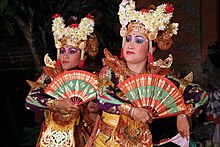Balinese people
This article needs additional citations for verification. (January 2007) |
 Balinese woman bring offering to the temple. | |
| Regions with significant populations | |
|---|---|
| Languages | |
| Balinese, Sasak, Indonesian | |
| Religion | |
| Balinese Hinduism | |
| Related ethnic groups | |
| Javanese, Sasak, Tenggerese, Sundanese |
The Balinese population of 3.0 million (1.5% of Indonesia's population) live mostly on the island of Bali, making up 89% of the island's population. There are also significant populations on the island of Lombok, and in the eastern-most regions of Java (e.g. the Municipality of Banyuwangi). it is the most populas hindu majority island in the world
Origins
The origins of the Balinese came from three periods: The first waves of immigrants came from Java and Kalimantan in the prehistoric times of the proto-Malay stock; the second wave of Balinese came slowly over the years from Java during the Hindu period; the third and final period came from Java, between the 15th and 16th centuries, at the time of the conversion of Islam in Java, aristocrats fled to Bali from the Javanese Majapahit Empire to escape Islamic conversion, reshaping the Balinese culture into a syncretic form of classical Javanese culture with many Balinese elements.
Culture

Balinese culture is perhaps most known for its dance, drama and sculpture. The culture is noted for its use of the gamelan in music. The island is also known for its form of Wayang kulit or Shadow play/Shadow Puppet theatre. It also has several unique aspects related to their religions traditions. Balinese culture is a mix of Balinese Hindu/Buddhist religion and Balinese custom.
The Balinese language itself does not recognize the word 'artist', because artistic life is part of the traditional daily life. In which the past everyone in the society participated.
Traditionally, a display of female breasts is free not regarded as immodest, Balinese women in the last century can often be seen with their bare chest, instead a display of the thigh is immodest. In modern Bali these ethics are normally not followed anymore, but visitors visiting Balinese temples they are advised to cover their legs.
Balinese has a unique naming system, in which a person's rank of birth or caste is reflected in the name.
Puputan
Puputan an act of war to the death, it was first noted by the Dutch during the colonialization of Bali. The latest act puputan was during the Indonesian war of Independence, with I Gusti Ngurah Rai as the leader. His name is now conmemorated as the airport name at Bali.
Religion
The vast majority of the Balinese believe in Agama Tirta, "holy-water religion". It is a Shivaite sect of Hinduism. Traveling Indian priests are said to have introduced the people to the sacred literature of Hinduism and Buddhism centuries ago. The people accepted it and combined it with their own pre-Hindu mythologies.[1] The Balinese from before the third wave of immigration, known as the Bali Aga, are mostly not followers of Agama Tirta, but retain their own animist traditions.
Festivals

Kuta Karnaval, Sanur Beach Festival.
References
- ^ Steve Lansing, Three Worlds of Bali. Praeger, 1983.
